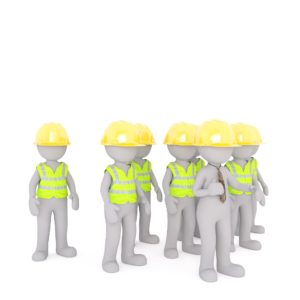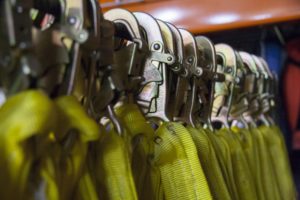
On any job site, having the right electrical safety gear is essential. For electrical projects, there are often special considerations, as some tasks can have unique hazards that require special gear.
Eye Protection
 Eye injuries are serious and for most electricians are a daily hazard. Having, and using, the right eye protection can make all the difference.
Eye injuries are serious and for most electricians are a daily hazard. Having, and using, the right eye protection can make all the difference.
Safety glasses are the bare minimum for any job site. Make sure that safety glasses have side-shields and the ANSI Z87.1 stamp. This means that they are designed and rated to provide an approved minimum protection from blunt impacts. They can also feature other rating letters which include droplet, fine dust, welding, or UV for added protection.
For tasks that produce sparks, metal debris, dust, or hazardous fumes, added protection may be required. Welders use heavy-duty welding face shields designed to protect them from sparks, hot metal, and from the intense UV light generated by the welding arc. For grinding, cutting, and spraying tasks, a full face shield should be worn in addition to normal safety glasses.
Ear Protection
Many tasks produce hazardous noise levels, either directly from tool usage or passively from equipment or machinery. According to OSHA guidelines, hearing protection is required if the ambient noise level over an 8-hour period is higher than 85 decibels. For reference, an electric blender is 88 decibels, and a car wash is 89 db.
Electrical Safety Gear
There are a variety of styles of ear protection to meet task requirements or user comfort. Foam earplugs are cheap and easy to use, but they can become tedious to insert and remove when working in intermittently loud environments. Over-ear muffs can be used, and are simple to raise and lower. Models are available that can attach directly to hardhats, but their size can be a hindrance when working in tight areas. In very loud locations, you may be required to wear ear plugs and ear muffs at the same time.
Fall Protection
Electricians often work at heights, either on roofs, scaffolds, or elevated work platforms. In some locations, even working on a step ladder can require fall protection gear.
When the potential exists to fall more than 6 ft., fall protection gear should be worn. This includes an approved and inspected harness and a lanyard with the correct weight rating. Always ensure that the fully extended length of the lanyard is short enough to prevent the worker from contacting the ground in the event of a fall.
Hand Protection
Hand injuries are the most common type of workplace injury, therefore selecting and using the right kind of gloves is vital.
Along with proper knife safety practices, using cut-resistant Kevlar gloves can greatly reduce the potential for cuts and scratches. In cold weather, ensure that insulated gloves are worn. When dealing with potentially hazardous chemicals, use gloves rated to handle the specific associated hazards.
Arc Flash Gear
 Electricians who work near live equipment should be aware of the potential of arc-flash explosion that results from a short circuit at high voltage. In addition, these arc-flashes produce intense heat, UV light, and pressure shock waves. In the event of catastrophic failure, the right gear can save your life.
Electricians who work near live equipment should be aware of the potential of arc-flash explosion that results from a short circuit at high voltage. In addition, these arc-flashes produce intense heat, UV light, and pressure shock waves. In the event of catastrophic failure, the right gear can save your life.
Based on the voltage and available fault current, a certain category rating of arc-flash gear should be worn. This gear includes coveralls, insulated rubber gloves, boots, balaclavas, full-body suits, and arc-flash rated face shields and helmets. As with any electrical safety gear, ensure that it is properly rated, inspected, and in good working order. Finally, when using insulated rubber gloves, check them thoroughly for any small cracks or tears, as even a small imperfection could lead to electrocution.

